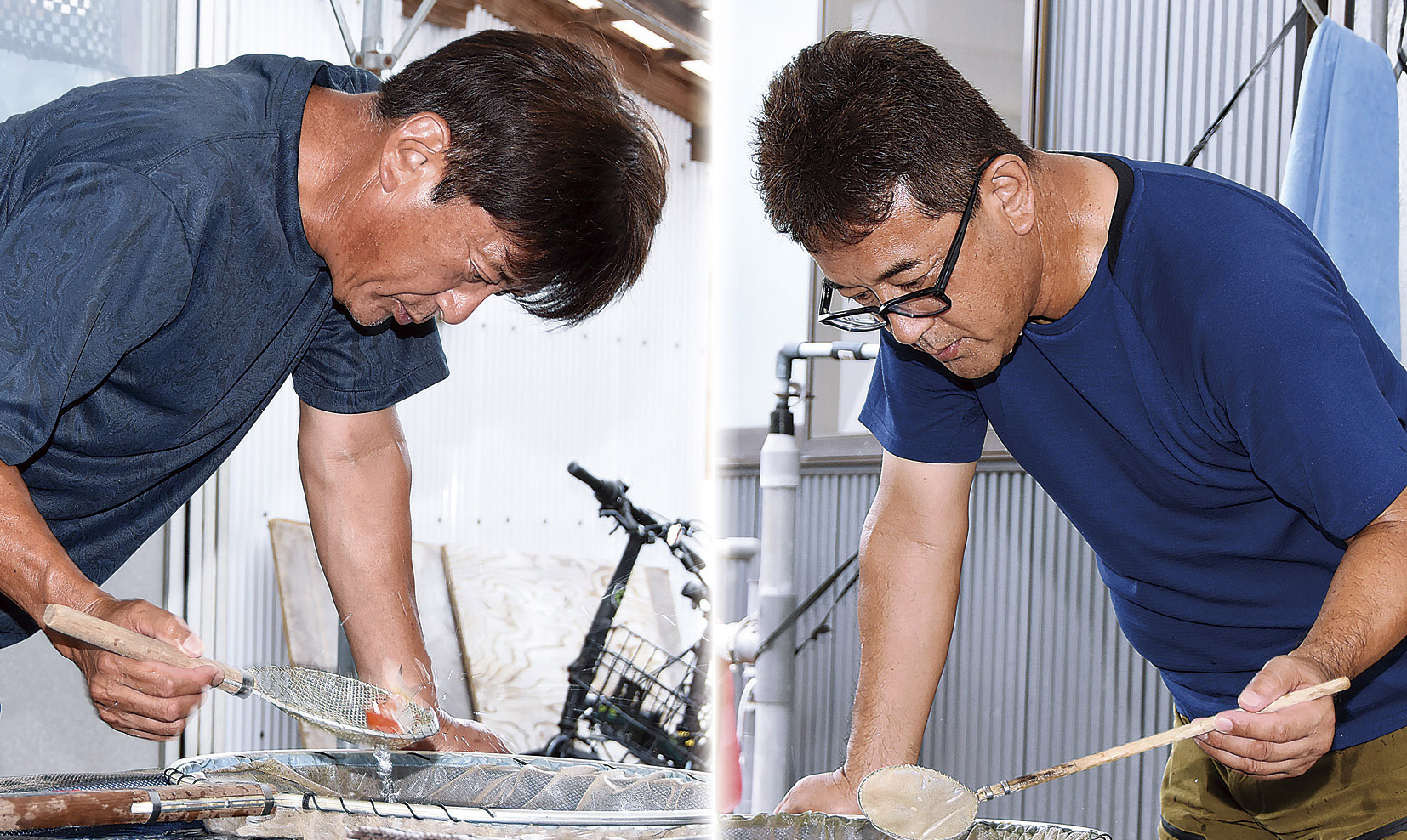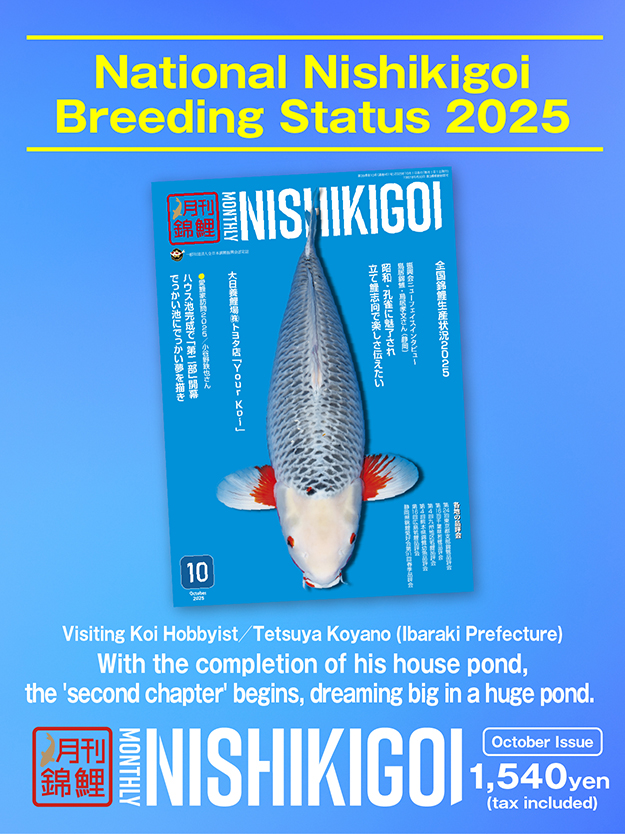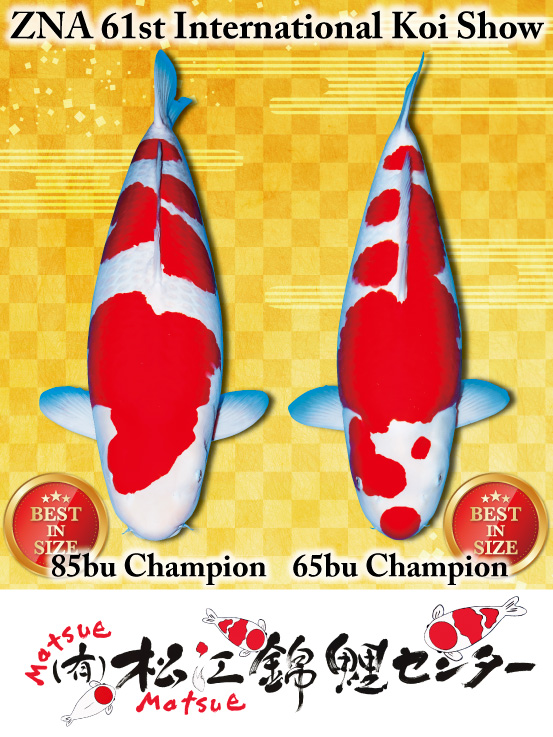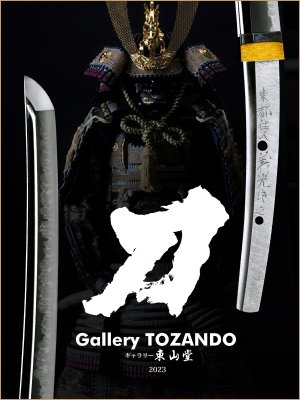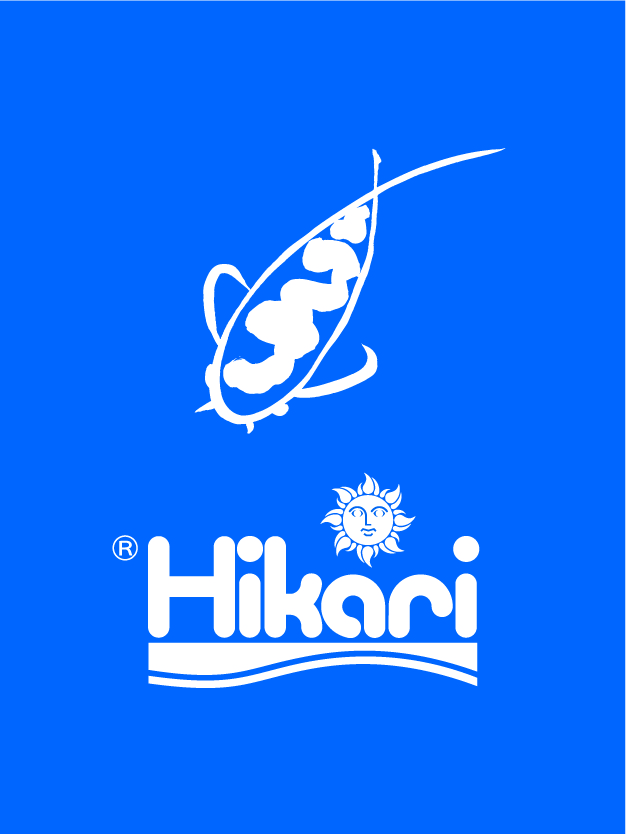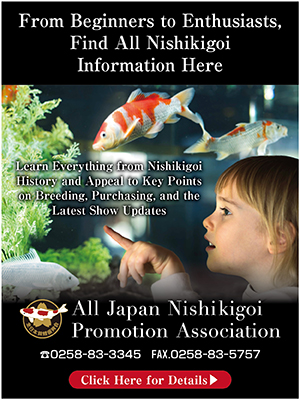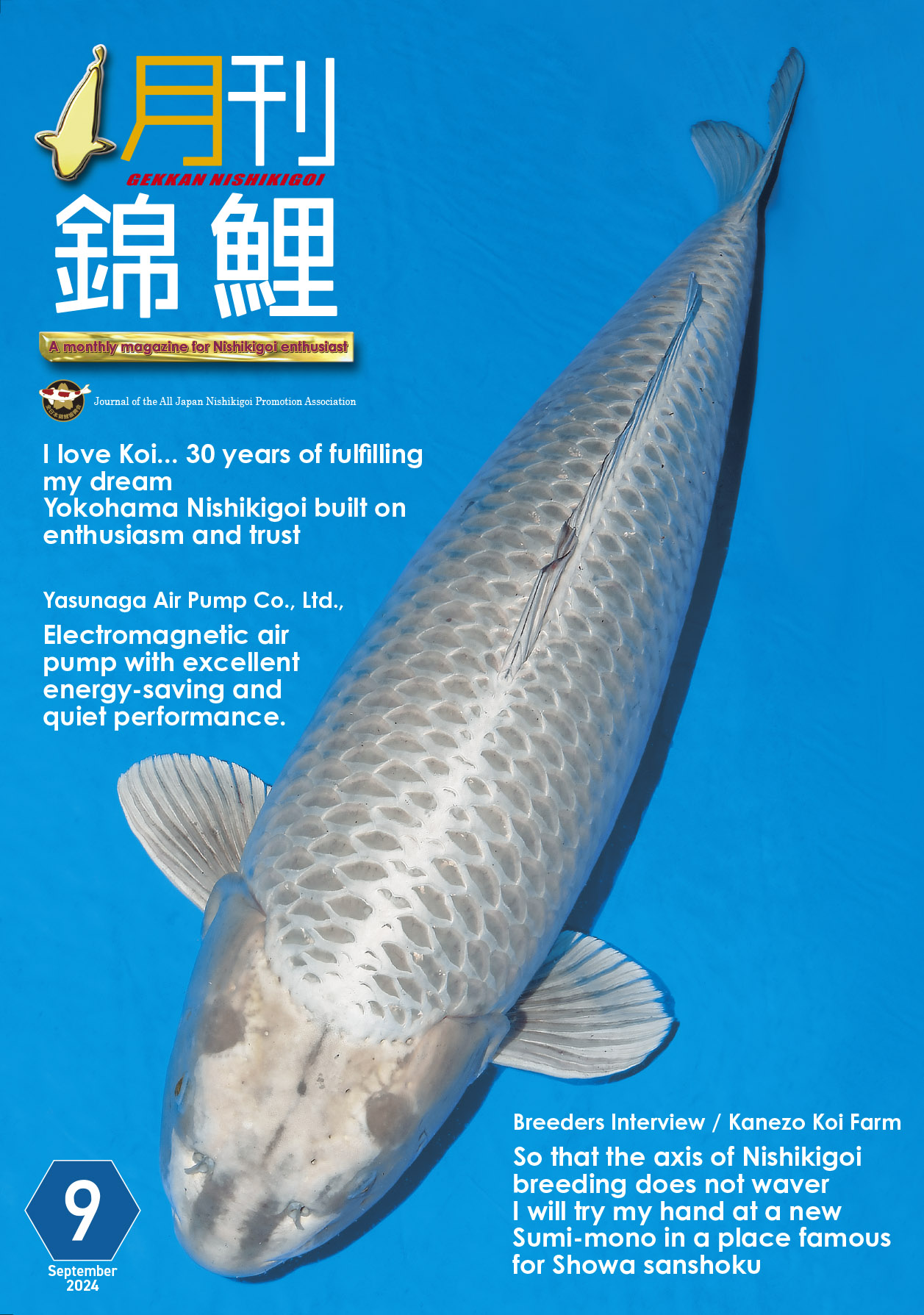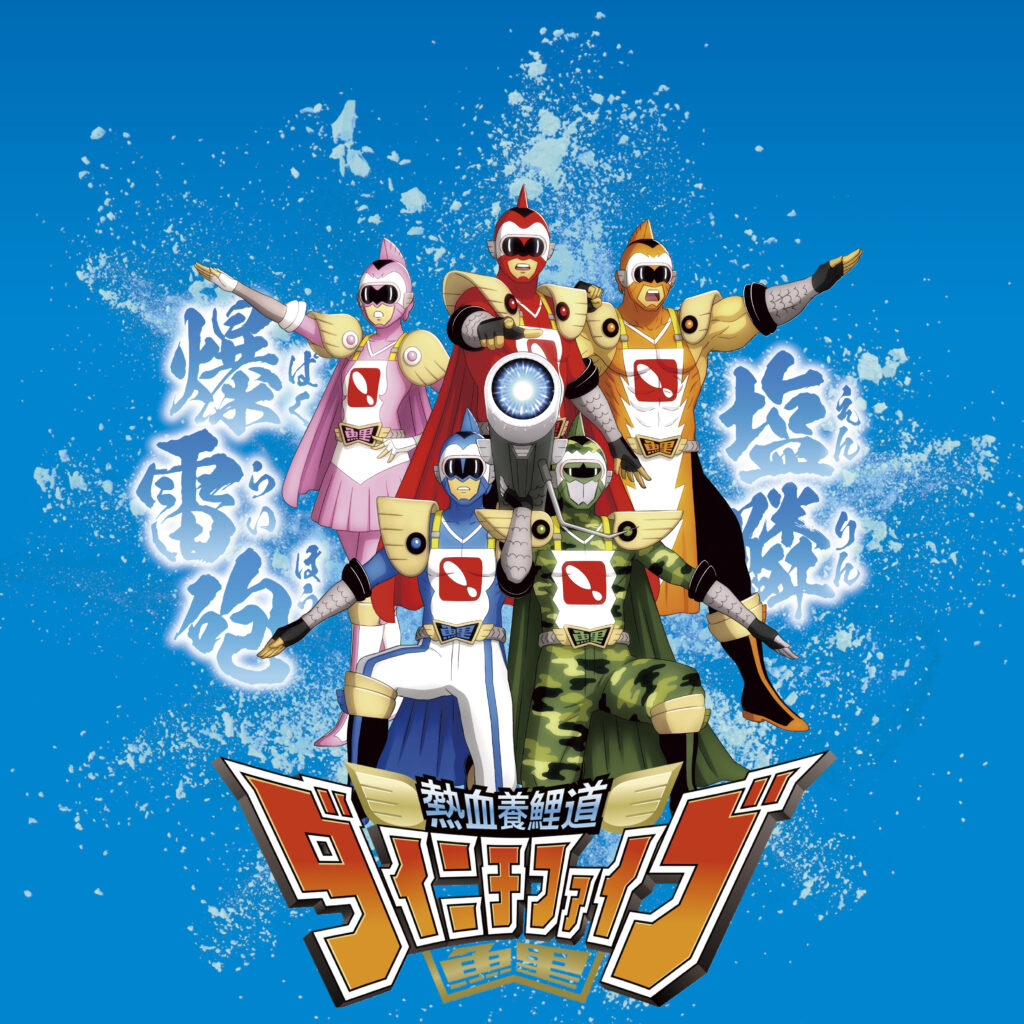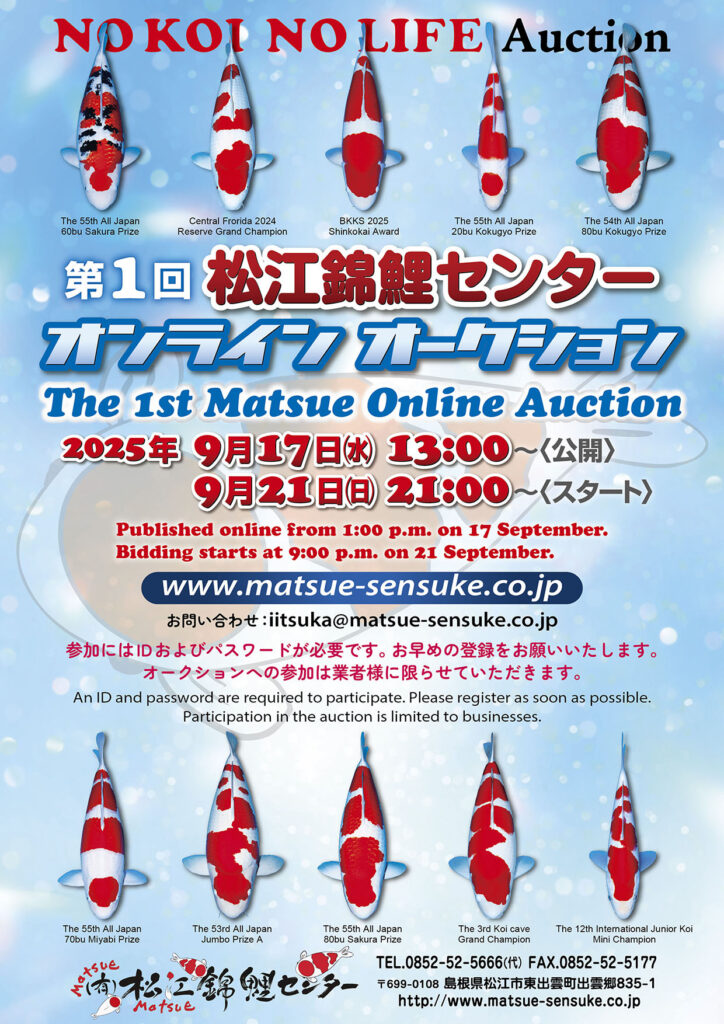Continuously improving koi is the ideal,
from “Sensuke“ to “New Matsue Kohaku“
ー What kind of koi does your aim to produce?
Hiroaki: Koi that can win the Grand Championship. We ourselves have produced koi that have received the Jumbo Prize A, so we have a deep understanding of what it takes. Even with continuous breeding every year, it’s considered very fortunate to produce one such fish in ten years. Larger companies with higher production volumes might produce one every three to five years, but for a company of our size, it takes about ten years. Therefore, the first thing is that they must stand the test of time. Maintaining longevity, youthfulness, and of course, maintaining their body shape… these are the things I value most. The reality is that although we may aim for short-term victories, it’s often difficult to achieve them. So, if we don’t strive for koi that are long-lived and robust, it’s difficult to cope with various challenges. Recently, we’ve also bred koi that can grow to 80 or 85 centimeters by the age of four. However, rapid growth is not everything. I believe that koi growth is more of a gradual process, often reaching their peak at around seven or eight years old, improving year after year. Continuous growth is the most important thing.
If you truly want to win the Grand Championship at koi show, the idea of “only breeding marketable koi” is not enough. Therefore, some koi may exhibit excellent qualities at the age of three or four, but due to certain flaws as parent koi their future potential cannot be foreseen. For this reason, some parent fish cannot be used.
ー For example, do you have the idea of breeding koi that are eye-catching even when they are two or three years old?
Hiroaki: We have such parent koi. After all, the company also has to consider commercial factors. However, among these parent koi, there are some that can continue to grow and become larger and larger. The parent koi we select are all those that can continuously produce better offspring. When we want to breed koi that are 1 meter long, we consider crossing specific two parent koi, because the probability of success is higher this way. Not all parent koi can breed koi that are 1 meter long, so we select a few from those with excellent genes, and judge based on probability that the combination of these two-parent koi has the highest possibility of producing koi that are 1 meter long.
ー When you’re using parent koi pairs, for example, is there a way to categorize them such that one combination reliably produces koi with a score of around 90 points, while another combination, although with a lower success rate, has the potential to produce exceptionally outstanding individuals?
Hiroaki: Yes, there is. With koi, there are those that can produce many koi that fetch a good price – we call these “winning bellies”. And then there are those that can produce a koi that wins the grand championship at a koi show – these are also called “winning bellies”. So, the pursuit of ultimate broodstock combinations always exists. Although we only have 11 Kohaku, one or two of them are such good bellies. For example, bellies that can produce fish of the Kokugyo prize level are very rare; we only have a few at our place. However, the physical condition of these remaining koi is extremely good.
ー For example, what type are the descendants of the “Setsuren” lineage, which is one of you main lines?
Hiroaki: They exhibit excellent growth. We successfully bred two distinct male lines: one with a lighter coloration and the other with a vibrant, glossy red. This artificial double mating resulted in offspring that excelled both in terms of quality and marketability. Our current breeding program is primarily based on the lighter-colored koi from this successful cross, as they readily inherit desirable male traits and appear to avoid any unwanted mixing of red hues.
ー Simply mating male and female fish with beautiful red qualities does not necessarily guarantee good results.
Hiroaki: It’s incorrect to say that crossing two 100% purebred koi will guarantee 100% purebred offspring. Based on my experience, I tend to believe that a ratio of 70% from the mother and 30% from the father is necessary to breed 100% excellent offspring. I often cross koi with different types of red coloration and carefully observe their descendants to see which type grows faster, or which type has excellent red coloration but slower growth, and so on. The initial breeding objective for the “Snow Lotus” variety was to establish a new foundation for broodstock. Therefore, in the first year, we extensively kept tosai and selected broodstock candidates from among them. The current breeding work has continued from that point.
And gradually, the offspring of “Hakuto” are becoming parents themselves. In two years, the offspring of “Setsuren” and “Hakuto” will likely form almost the entire basis of our parent stock. Their growth and the quality of their red color are excellent. Therefore, our current koi are not so much “Sensuke” as they are “New Matsue Kohaku.” The image of Sensuke that everyone has is probably the persimmon-red, lightly colored koi that have been talked about for a long time, but that has completely changed now.
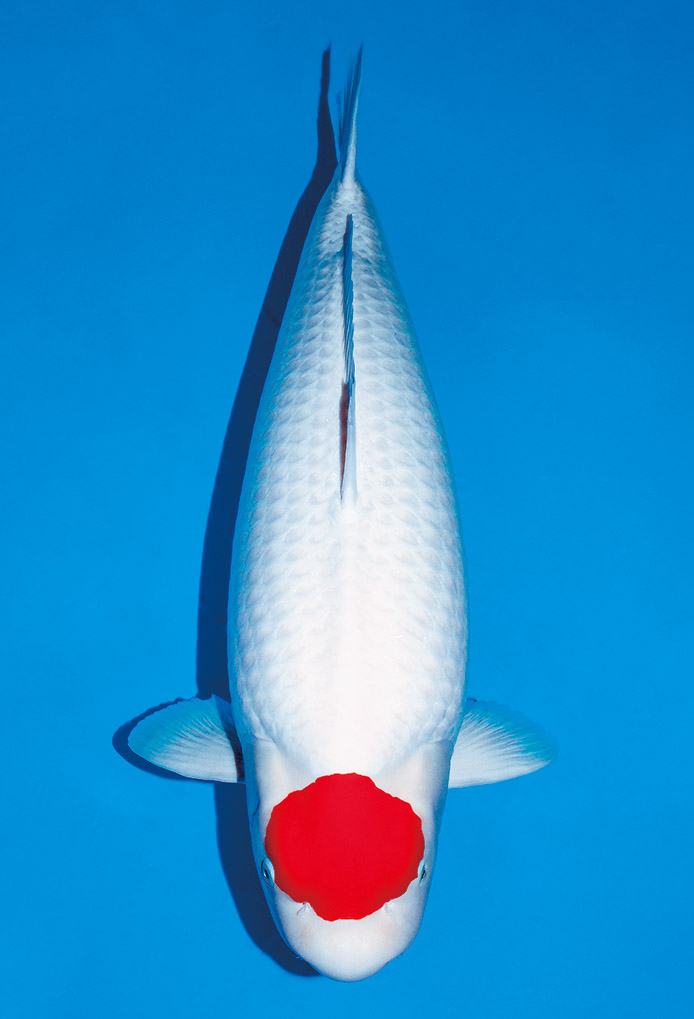
The 54th All Japan Nishikigoi Show / Best in varieties
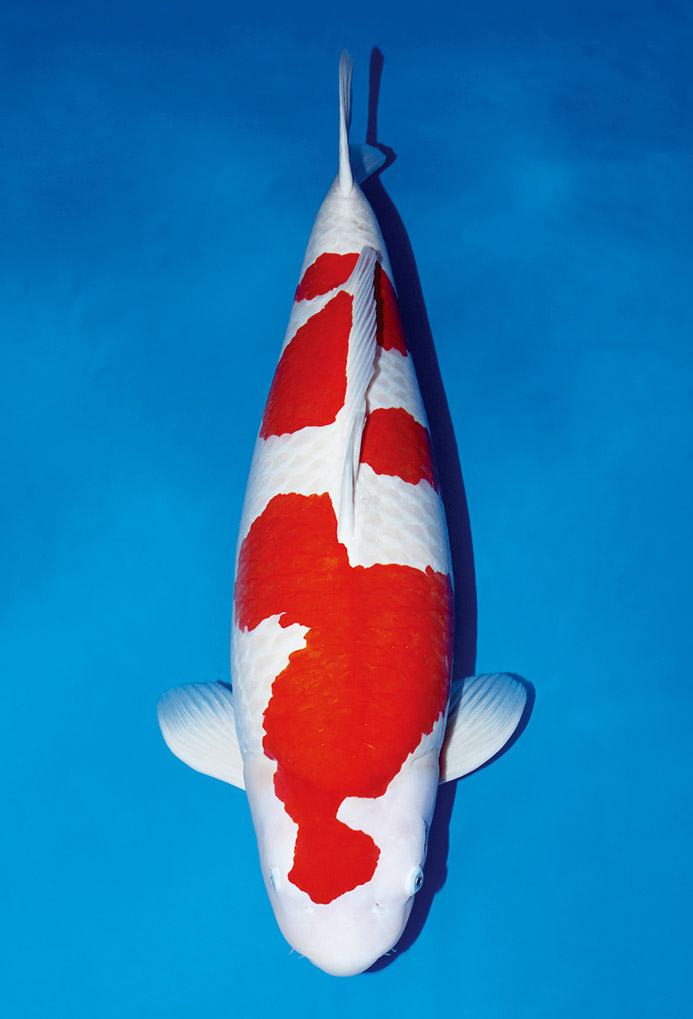
ー You don’t have any particular attachment to the traditional Sensuke, then?
Hiroaki: Saying I have no attachment might be a bit different… To be honest, both the president and I, we’ve never actually seen the real Sensuke. This is a history built by my father (Chairman Shoichi Iizuka) and the late Mr. Miyatora (owner of Miyatora Koi Farm in Kawaguchi, Mr. Hajime Miyatora). We’ve only heard stories about it. I still think my father’s eye for Kohaku is amazing, and I respect him for it. Compared to those people, we’re like fledglings, nowhere near the level where we can talk about Sensuke. The only time I saw some was after I graduated high school, when my father took me to Mr. Morita’s place in Yamaguchi prefecture. Even those, my father said, were quite far removed from the original Sensuke.
The koi we raise originated from a variety called “Morita Sensuke” left by my father. However, through long-term observation, we found that it had many strengths, but also exposed some weaknesses, making us realize some areas for improvement. To raise good koi, we must eliminate its bad parts, right? Therefore, our current development direction is to create our own distinctive variety called “Matsue Koi,” rather than simply continuing “Sensuke”.
ー Although the names of various bloodlines still remain, the blood itself naturally becomes diluted, doesn’t it?
Hiroaki: I think that’s unavoidable. In the 36 years since I started, I’ve seen many different fish, but they’re completely different from what they used to be, and the level that customers demand has also changed drastically. I’ve seen many wonderful koi, and back then I kept working thinking, “I wish I could make koi like this,” but I wonder how I would feel if I saw those fish now… Not limited to Kohaku, the level of koi has reached a very high level, so I think it’s a very difficult task to continue creating them while competing and improving.
ー At the All Japan Koi show, 1-meter koi have become the norm, and they are also quite beautiful. With various breeders producing such koi, don’t you feel a sense of hitting a wall, wondering what else you should aim for?
Hiroaki: Oh, we’re constantly battling anxiety. Every year is filled with anxiety. We worry about things like whether we’ll only get plain red offspring from the parents we thought were good, and we consider the pairings every year while plagued by various anxieties. We’ve drastically changed our production strategy twice. The first time was when we tried to establish a base with “Gyokurin” and “Suzuran,” but this was also extremely radical.
ー That was when you decided to focus production solely on Kohaku.
Hiroaki: That’s right. At the time, it was becoming difficult to produce Shiroutsuri and Kumonryu, so we decided to increase the weight of Kohaku even if it meant abandoning other varieties.
We wanted to create a base with Gyokurin and Suzuran, but we were having trouble finding good males to breed with. That’s when Mr. Kikitsu, the president of Kyowa Suisan (Chiba), and Mr. Saeki told me, “We have a male we want to show you, so come visit sometime.” And that’s when Mr. Murata provided us with a male free of charge. Even though we had the desire to create good koi, we had so little money that I think they felt sorry for us and gave it to us. I am truly grateful for that even now.
ー And did you renew the parent koi of your Kohaku about 7-8 years ago?
Hiroaki: I think the third renew will definitely come. Whether or not to do it is up to the individual producer, but I think if we hadn’t done it, we wouldn’t be where we are today. Because we don’t have a large production volume, we’ve been thinking about various things with a small scale. I think that’s the eternal task for those who create Kohaku. Today is the second selection of the second koi, and after Bon Festival, we’ll have the third and fourth crop selections. The first selection of the fourth crop hasn’t come yet, but we’re focusing entirely on Kohaku.
― Produced four times, that’s impressive!
Hiroaki: There aren’t many, just one or two. But to breed good Kohaku, you have to produce a lot and then select from them.
(To be continued in the part 2.)

